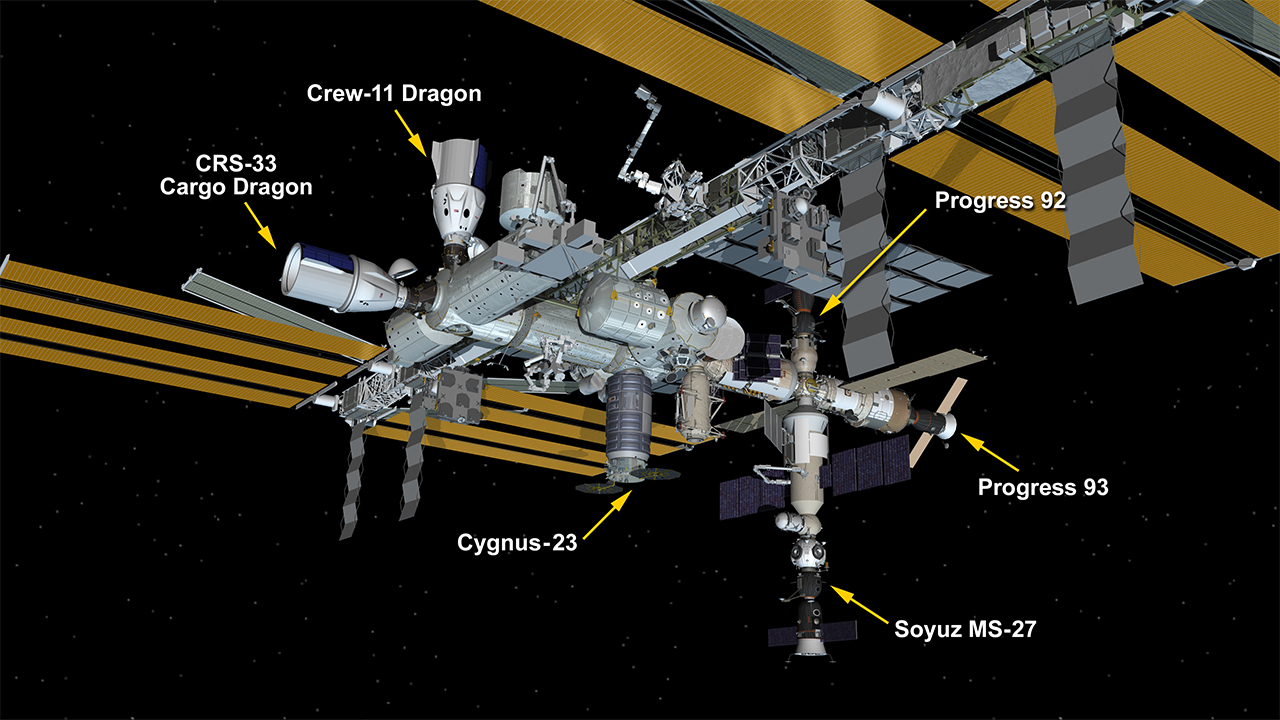10.10.2025

The International Space Station (ISS) recently welcomed three spacecraft that delivered much-needed cargo to support Expedition 73’s seven-member astronaut crew, ensuring the crew and Station are supplied with food, water, clothing, and equipment. Meanwhile, the crew continued with its usual collection of experiments and maintenance tasks.
As the Progress, Cargo Dragon, and Cygnus spacecraft continue to fly vital missions to keep humanity’s presence in low-Earth orbit going, Japan is also readying its HTV-X cargo spacecraft for its first flight this month. Sierra Space’s Dream Chaser, however, another prospective cargo delivery spacecraft, is no longer targeted to fly to ISS on its first demonstration mission — a significant setback for the Dream Chaser program.
SpaceX launched the first of three ISS cargo missions to take place within three weeks. The CRS-33 mission flew on Aug. 24 from Space Launch Complex 40 (SLC-40) at the Cape Canaveral Space Force Station (CCSFS), with Cargo Dragon C211 docking to the Station’s Harmony module the following day.
C211 docked to the Harmony forward port, as the spacecraft was equipped with a “booster trunk” that could perform reboosts of the Station. The Cargo Dragon carried 2,300 kg of cargo to the ISS, with the trunk’s boost kit being a major contribution to the cargo complement. The boost kit has, for the most part, functioned properly, except for one reboost burn that was aborted after less than four minutes.
The C211 spacecraft attempted a 19-minute long reboost burn on Sept. 25, but the Dragon’s systems failed to complete a scheduled swap from one fuel tank to another, and controllers manually aborted the burn. After analysis and planning, the spacecraft successfully completed a reboost burn on Sept. 29.
The Cargo Dragon also carried several experiments to the Station, including a pair of 3D printing experiments — one for metal parts and another for medical implants to help regenerate nerves after injury — as well as other science investigations. Other cargo included spacewalk and computer equipment, Station hardware, food, clothing, and other items.
A Roscosmos Soyuz launched the next ISS cargo ship from Site 31/6 at Baikonur Cosmodrome on Sept. 11. Progress MS-32 launched atop a Soyuz 2.1a and reached the Station in around 48 hours, with docking occurring on Sept. 13. The spacecraft docked to the Zvezda aft docking port on the Russian segment; the roughly 2,600 kg of cargo aboard included fuel for reboosts, water, experiments, food, clothing, and other items.
On Sept. 14, just three days after Progress MS-32’s launch — and 21 days after CRS-33’s flight — the Cygnus XL S.S. William C. “Willie” McCool launched atop a Falcon 9 from SLC-40 at CCSFS. This was the first flight of the Cygnus XL version of Northrop Grumman’s cargo spacecraft, featuring an eight-meter-long cargo module.
The Cygnus XL’s stretched cargo module offers more capacity than the earlier Enhanced Cygnus and the initial standard version launched in 2013. NG-23 carried 5,000 kg of cargo to the Station, including a variety of experiments, as well as the usual selection of hardware and consumables for the crew and Station systems.
NG-23 was originally supposed to be berthed to the ISS Unity module’s nadir port on Sept. 17. However, a pair of engine burns to get the Cygnus XL to the Station shut down early; engineers traced the shutdowns to an overly conservative software safeguard. Controllers succeeded in getting the Cygnus to ISS the following day after reworking the engine burn plan, and astronauts safely used the Canadarm2 to berth NG-23 to the Station.
Cygnus XL NG-23 is now berthed to Unity, while Progress MS-32 is still docked to the Zvezda aft port, and the CRS-33 Cargo Dragon is currently docked to Harmony’s forward port. Each of these spacecraft will spend the coming months attached to the Station, although NG-23 will need to be moved and temporarily held away from the Station by the Canadarm2 when Soyuz MS-28 arrives in November.
This maneuver to hold the Cygnus XL away from the Station is necessary to ensure adequate clearance for the Soyuz to dock with the Russian segment’s Rassvet module, which is attached to the Zarya module and thus close to the Unity node. If Canadarm2’s grapple of Cygnus for an extended period causes an unsafe condition, there are contingency plans to end NG-23’s mission early.
The NG-23 mission is otherwise scheduled to last until this coming March, while Progress MS-32 is expected to remain attached to the Russian segment until February. Both NG-23 and Progress MS-32 will carry trash and conduct destructive reentries. NG-23 will also launch several cubesats into orbit before its deorbiting and reentry.
CRS-33 will remain docked to Harmony until this December, when it will return to Earth for an intact splashdown off the southern California coast. The Dragon will carry critical experiment samples and hardware to be offloaded after recovery, such as spacesuit parts, that need refurbishment on Earth.
The Cargo Dragon is currently the only ISS cargo spacecraft that offers intact downmass and upmass cargo capability. The Sierra Space Dream Chaser, based on the NASA Langley HL-20 concept, was selected to fly commercial cargo missions to the ISS with downmass capability.
Dream Chaser is not yet ready to fly cargo missions, and a recent rework of the contract between NASA and Sierra Space will further delay, if not outright cancel, any Dream Chaser missions to the Station. The Dream Chaser Tenacity, the first flight vehicle, was being prepared for a demonstration mission to the ISS, but that has now changed to a free-flying mission, scheduled to be flown no earlier than late 2026.
Dream Chaser is also no longer guaranteed seven cargo resupply missions to the ISS. Given the relatively short timeframe until the Station’s planned retirement and disposal around 2030, it is very possible that the spacecraft will not be tapped to fly any cargo missions to the ISS.
In better news for the ISS program, a new Japanese cargo spacecraft is just weeks away from its first flight. Japan developed the HTV-X spacecraft as a replacement for the earlier HTV cargo ship that launched atop the now-retired H-IIB. The HTV-X 1 mission is scheduled to fly on Oct. 20 atop a H3-24L rocket from the Tanegashima Space Center.
Although the HTV-X does not offer intact downmass capability, it does provide up to 5,850 kg of cargo capacity to ISS. The spacecraft offers the ability to carry large items of unpressurized cargo that other cargo ships would not be able to fly to the Station, in addition to 4,070 kg of cargo in the HTV-X’s pressurized compartment.
Expedition 73 is scheduled to last until Dec. 9, when Soyuz MS-27 is expected to undock from the Station. Once the Soyuz spacecraft carrying current ISS commander Sergey Ryzhikov, Alexey Zubritsky, and NASA’s Jonny Kim undocks from the Russian segment’s Prichal module, Expedition 74 will officially begin.
The next launch to the Station after the HTV-X 1 mission will be the Soyuz MS-28 crewed mission, which is currently set for Nov. 27. NASA astronaut Christopher Williams will join Roscosmos’ Sergei Kud-Sverchkov and Sergei Mikayev on this flight for an eight-month tour of duty on the ISS.
Soyuz MS-28 and Progress MS-33, scheduled to launch on Dec. 18, will be the last launches to ISS in 2025. The current U.S. government shutdown does not affect Station operations, but it is impacting progress updates from NASA. Future ISS activities may be affected, depending on the budget and staffing levels that are ultimately approved for Fiscal Year 2026.
Just before the U.S. government shutdown, on Sept. 30, the NASA Office of Inspector General (OIG) issued a report highly critical of Collins Aerospace’s performance in maintaining the Station’s Shuttle-era spacesuits, known as Extravehicular Mobility Units (EMUs). These EMUs are based on design work performed 50 years ago.
The EMU is reliant on increasingly obsolete parts, and the Station’s EMUs are well past their originally intended 15-year design life. The OIG report noted quality issues, shortages of critical spare parts, and significant delays in producing the necessary spares, while stating that the contractor’s performance has declined over the past few years.
There have been no extravehicular activities (EVAs), also known as spacewalks, performed on the Station since May 1, and it is not publicly known when the next EVA is scheduled. NASA has contracted Axiom Space to produce a replacement spacesuit for EVA and lunar operations, but it is not yet ready.
Quelle: NSF
